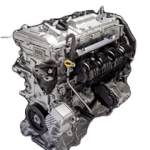Prius rebuilt engine with 3 years warranty Available Call for details
Prius Engine internal combustion
The 4-cylinder engine in the Toyota Prius is a gasoline engine that operates according to the Atkinson cycle. The Prius engine therefore has a very high thermal efficiency.
Engine Data:
Cyl. Content: 1.8 L
Max. Rpm: 5000 rpm.
Power: 57 Kw (78 HP) at 5000 rpm.
Max. Coupling: 115 Nm at 4200 rpm.
Atkinson cycle versus Miller cycle engine
The 4-cylinder gasoline engine in the Toyota Prius works, according to Toyota, according to the Atkinson cycle principle.
What is an Atkinson cycle engine?
James Atkinson has developed a engine that makes it possible to vary the volume of the inlet / outlet stroke with the compression stroke through ingenious transmission.According to Atkinson, the purpose of this adjustment is to reduce the power loss that occurs during the compression stroke in a conventional engine. The reduction in power loss during the compression stroke is greater than the loss of capital from the labor force. The return will therefore increase.This principle, however, is otherwise applied by Ralp Miller.Ralph Miller has designed the Miller cycle engine.


What is a Miller cycle engine?
With the Miller cycle engine, the difference in volume layers is achieved by keeping the inlet valve longer open, so that a part of the volume through the inlet valves leaves the cylinder during the compression stroke. The compression stroke volume in this type of motor is about 70% to 80% of the inlet stroke volume.
The compression volume loss is compensated for in the Miller cycle engine by applying turbo compression during the inlet stroke.In this manner, the residual energy in the exhaust gases is used by the engine to increase the overall efficiency of the engine. The car manufacturer Mazda used this engine in the 90s in the Mazda Millennia and Eunos 800.
How does the Prius engine work?
The Toyota engine operates with a variable valve timing, which allows to adjust the duration of the inlet stroke and the compression stroke independently. In this manner, it is possible to vary the volume of the inlet / outlet stroke with respect to the compression / work stroke.The Prius engine inlet valves remain open during a% part of the compression stroke, so that part of the fresh gasoline / air mixture is pressed back into the intake manifold. This reduces pump losses during the compression stroke.
By using variable valve timing intelligence (VVT-i), it is possible to operate this engine in an efficient and efficient manner under all circumstances and taxes. A motor according to this price has high thermal efficiency.
The engine in the Toyota Prius is actually a combination of a motor according to the Atkinson and Miller principle.
With the Prius engine, however, the ingenious mechanical construction of the Atkinson engine and the Miller engine turbocharger lacks . The Toyota Prius is the first and only single production vehicle with this type of engine. The weight of the engine is also kept as low as possible using light materials. Minimizing the various moving parts as well as reducing the valve springs and optimizing the resilience have a positive effect on the frictional power loss. All this helps to further improve the efficiency of this engine.
Almost all the engines currently in the cars are working according to the conventional Otto principle, with the impact volume of the inlet / exhaust stroke being equal to that of the compression / work stroke. There are some exceptions to the rule at this time. Various manufacturers have already made use of vaporized valve timing engines.



